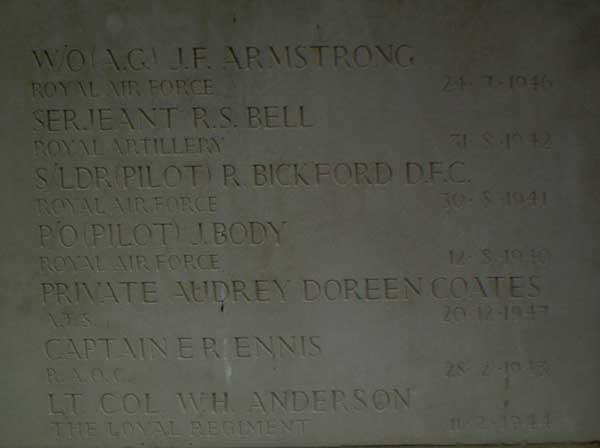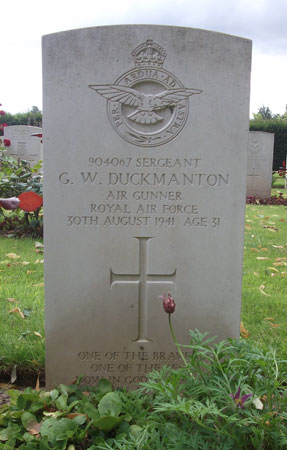Halifax L9518 near Pocklington.
On the night of 29th / 30th August 1941 the crew on this 76 Squadron aircraft undertook an operational flight to bomb Frankfurt and took off from Middleton St.George at 21.13hrs. Eventually this crew bombed the target and made for home but whilst over the Finningley area and while heading north the aircraft began to suffer engine trouble. Some time later both starboard engines began to splutter as the fuel began to run out of fuel and the two engines then failed. Flying at around 2000ft the pilot ordered the crew to abandon the aircraft when another engine began to fail, all members of his crew complied with these orders but the rear gunner delayed his exit and he was too low for his parachute to work properly and was killed. The pilot was thought to have attempted to escape the aircraft through the top escape hatch but was probably struck by a wind-milling propeller and it is also reported that his parachute then caught in the tail of the aircraft. The pilot was also killed in the resulting crash near Pocklington at 04.15hrs although the exact location of where the aircraft came down is not yet known. For anyone to be in the air on an operational flight while only in the rank of Corporal was very rare by this date in the War though he would have been one of the first Halifax flight engineers.
Halifax L9518 was built to contract 692649/37 by Handley Page Ltd. at Radlett. It was allocated to 35 Squadron on 15th March 1941 and was taken on charge by 35 Squadron at Linton on Ouse later on 20th April 1941. On 5th May 1941 it was transferred to 76 Squadron at Linton on Ouse and moved to Middleton St.George with the squadron on 4th June 1941. It was slightly damaged there on 19th June 1941 when it overshot on landing. After assessment by 43 Group D.A. Cat.Ac/FA damage was the damage assessment and on 17th August 1941 it was returned to 76 Squadron. As a result of the major incident near Pocklington on 30th August 1941 Cat.E2/FB Burnt was the damage assessment. The aircraft was struck off charge on 3rd September 1941.
Pilot - S/Ldr Richard Bickford DFC RAF (37462), aged 30. Killed, cremated Darlington.
Rear Gunner - Sgt George William Duckmanton RAFVR (904067), aged 31. Buried Nottingham Road Cemetery, Derby.
Observer - P/O Philip Henry Inigo-Jones RAFVR (87362).
Flight Engineer - Cpl Peter Davies Randall RAF (567345).
Wireless Operator / Air Gunner - F/Sgt James Flannigan RAFVR (759151).
Wireless Operator / Air Gunner - Sgt John Medcalf Reilly RAFVR (1250266).
Richard Bickford and the memorial plaque in Darlington's Western Cemetery. He was born on 4th January 1911 in Wimbledon. He was made an Acting P/O on probation on 7th January 1936, this was made permanent on 28th October 1936, having been posted to 10 Squadron in the months prior to this. He rose from P/O to F/O on 28th June 1938 and to F/Lt on 6th May 1939. On 15th October 1939 he crash landed Whitley K9023 at Dishforth airfield. As F/Lt he was awarded the DFC on 17th May 1940 and soon after was the pilot of Whitley P4962 which crashed on take off from Topcliffe in June 1940. He was posted to command E. Flight at 10 OTU following his Tour with 10 Squadron and on 28th November 1940 crashed Magister L5958 on landing at Abingdon with this unit. S/Ldr Bickford later returned to operational flying to commanded 76 Squadron at Middleton St George. S/Ldr Bickford was cremated in Darlington and was thirty years old, he left a young son who later became a pilot with British Airways.
George Duckmanton's grave in the CWGC plot in Nottingham Road Cemetery, Derby. He was born in Chesterfield in June 1910 but was married to a girl from Potterspury, Northamptonshire.



James Flannigan bailed out of Halifax L9567 on 14th September 1941 near Bedford on return from Ops to Brest, sadly one member of his then crew was killed when the aircraft crashe nearby. He was sadly lost on 31st October 1941 while flying in Halifax L9602 on Ops to Dunkirk. He was twenty years old and is commemorated on the Runnymede Memorial.
Philip Inigo-Jones had trained as a civilian pilot before the war and had gained a Royal Aero Club aviators' certificate (Cert.No.16991). Earlier in the war he had served with 78 Squadron and was posted to 76 Squadron on 18th June 1941. He survived the war and remained in the RAF until 1954. His first wife later re-married Douglas Bader.
Sgt Randall was killed on 30th December 1941 when Halifax L9615 of 76 Squadron failed to return from an operational flight. He is commemorated on the Runnymede Memorial.